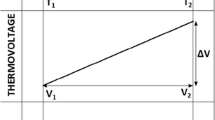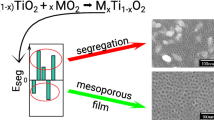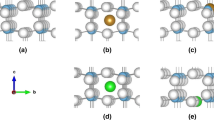Abstract
The reversible change of oxygen content observed by gravimetric measurements on tantalum-doped rutile (TiO2) between specified states of oxidation and reduction is proportional to the dopant concentration. These measurements indicate that donordopants are ionically compensated by additional oxygen uptake in the oxidized state. The range of this reversible change in oxygen stoichiometry is up to more than an order of magnitude larger than the oxygen non-stoichiometry of the undoped TiO2. Self-compensation has been measured in TiO2 with up to 10 at% Ta+5 and a single-phase region from TaO +50.1 Ti +30.1 Ti +40.8 O2 to Ta +50.1 Ti +40.9 O2.05 has been confirmed. The gravimetric measurements can be explained by either the creation of metal-deficit point defects (self-compensation) or a model involving a shear structure.
Similar content being viewed by others
References
P. Kofstad, J. Less-Commom Met. 13 (1967) 635.
L. N. Shen, O. W. Johnson, W. D. Ohlsen and J. W. Deford, Phys. Rev. B10 (1974) 1823.
C. Picard and P. Gerdanian, J. Sol. Stat. Chem., 14 (1975) 66.
P. H. Odier, J. F. Baumard, D. Panis and A. M. Anthony, ibid. 12 (1975) 324.
P. Kofstad' J. Phys. Chem. Sol. 23 (1962) 1579.
K. S. Forland, Acta. Chem. Scand. 18 (1964) 1267.
J. B. Moser, R. N. Blumenthal and D. H. Whitmore, J. Amer. Ceram. Soc. 48 (1965) 384.
D. S. Tannhauser, Sol. Stat Comm. 1 (1963) 223.
R. N. Blumenthal, J. Coburn, J. Baukus and W. M. Whitmore, J. Phys. Chem. Sol. 27 (1966) 643.
Y. Yahia, Phys. Rev. 130 (1963) 1711.
J. F. Marucco, J. Gautron and P. Lemasson, J. Phys. Chem. Sol. 42 (1981) 363.
H. P. R. Frederikse, J. Appl. Phys. 32 (1961) 2211.
P. F. Chester, ibid. 32 (1961) 2233.
S. Andersson, Acta. Chem. Scand. 11 (1957) 1641.
B. G. Hyde and L. A. Bursill, in “The Chemistry of Extended Defects in Non-Metallic Solids” edited by L. Eyring and M. O'Keefe (North-Holland, Amsterdam, 1970) p. 347.
J. S. Anderson and R. J. D. Tilley, J. Sol. Stat. Chem. 2 (1970) 472.
L. A. Bursill and B. G. Hyde, Phil. Mag. 23 (1970) 3.
J. S. Anderson, National Bureau of Standards Publication Number 364 (U.S. Government Printing Office, Washington, D.C., 1972) p. 295.
R. M. Gibb and J. S. Anderson, J. Sol. Stat. Chem. 4 (1972) 379.
Idem, ibid. 5 (1972) 212.
R. N. Blumenthal and D. H. Whitmore, J. Electrochem. Soc. 110 (1963) 92.
J. S. Anderson and A. S. Khan, J. Less-Common Met. 22 (1970) 219.
S. Zador, Ph.D. thesis, University of London (1969).
N. G. Eror, J. Sol. Stat. Chem. 38 (1981) 281.
E. J. W. Verwey, P. W. Haaijman, F. C. Romeijn and G. W. Oosterhout, Philips. Res. Rept. 5 (1950) 173.
F. A. Kroger and H. J. Vink, in “Solid State Physics” Vol. III, edited by F. Seitz and D. Turnbull (Academic Press, New York, 1956) p. 307.
R. F. Brebrick, “Progress in Solid State Chemistry” Vol. III (Pergamon Press, Oxford and New York, 1966) p. 213.
G. Mandel, Phys. Rev. A134 (1964) 1073.
Idem, ibid. A136 (1964) 826.
F. A. Kroger, in “Physical Chemistry: An Advanced Treatise” Vol. X, edited by H. Eyring (Academic Press, New York and London, 1970) p. 229.
N. G. Eror and D. M. Smyth, in “The Chemistry of Extended Defects in Non-Metallic Solids” edited by L. Eyring and M. O'Keefe (North-Holland, Amsterdam, 1970) p. 62.
J. L. Waring and R. S. Roth, J. Res. Natl. Bur. Std. 72A (1968) 177.
M. Pechini, U.S. Patent Number, 3,330,697, July 11, 1967.
U. Balachandran and N. G. Eror, J. Sol. Stat. Chem. 39 (1981) 351.
J. P. Coughlin, National Bureau of Standards Bullitin Number 542 (U.S. Government Printing Office, Washington, D.C., 1954).
V. R. Porter, Ph.D. thesis, The Pennsylvania State University (1965).
H. Reiss, C. S. Fuller and A. J. Pietruszkiewicz, J. Chem. Phys. 25 (1956) 650.
U. Balachandran and N. G. Eror, J. Sol. Stat. Chem. 40 (1981) 85.
S. Andersson and J. Galy, ibid. 1 (1970) 576.
A. Magneli, Arkiv. Kemi. 1 (1950) 513.
A. D. Wadsley, Acta Cryst. 14 (1961) 660.
J. S. Anderson, “Advances in Chemistry” Vol. 39 (American Chemical Society, Washington, D.C., 1963) p. 1.




